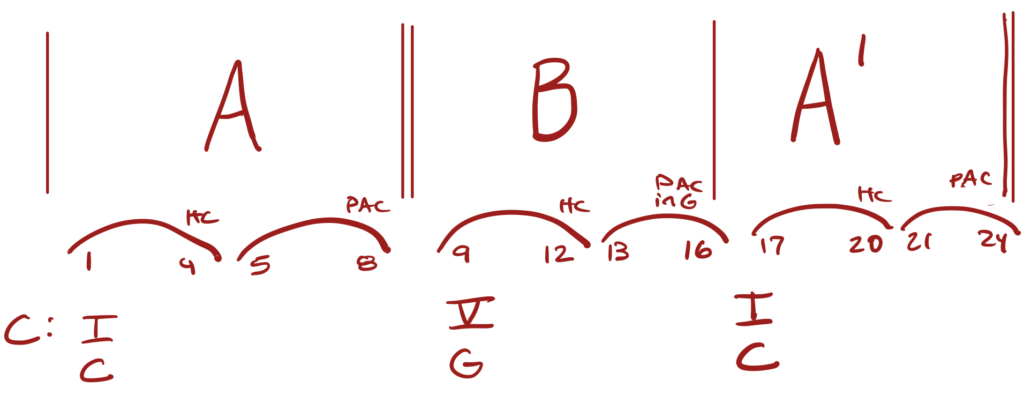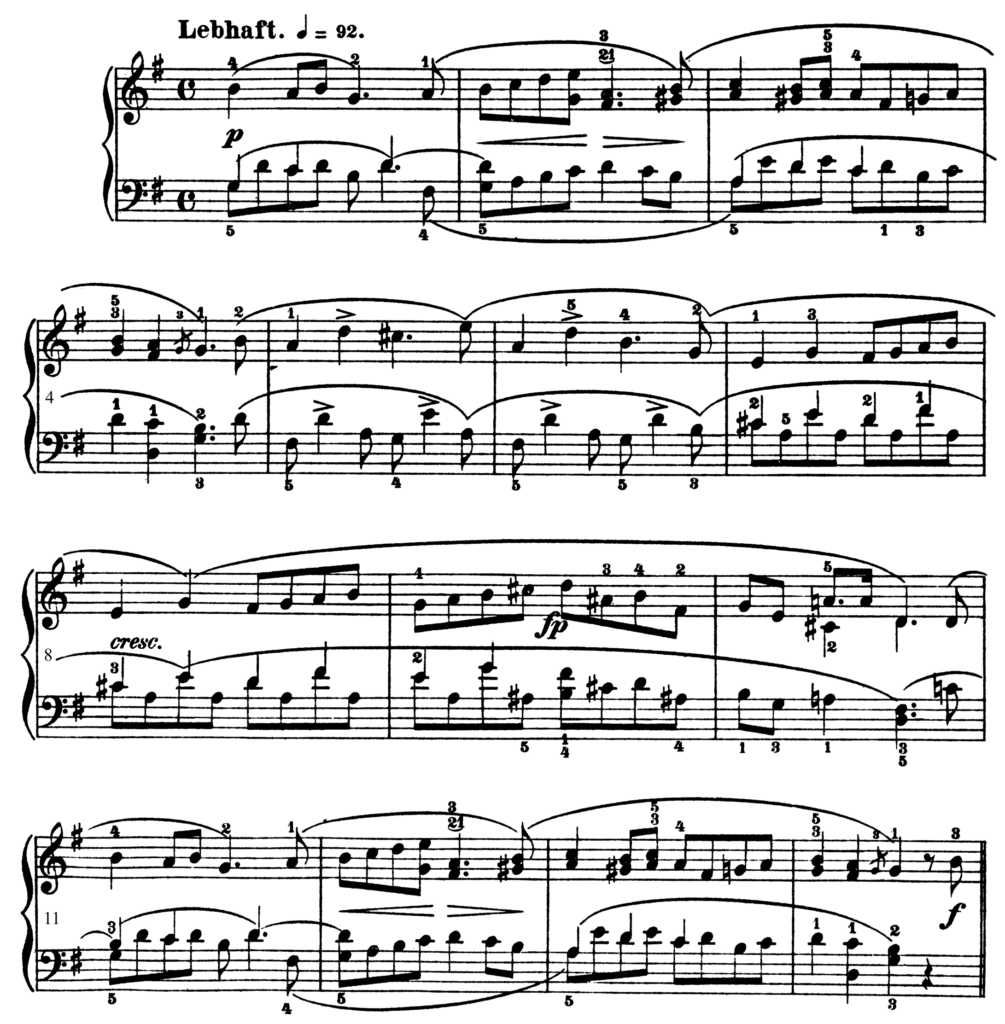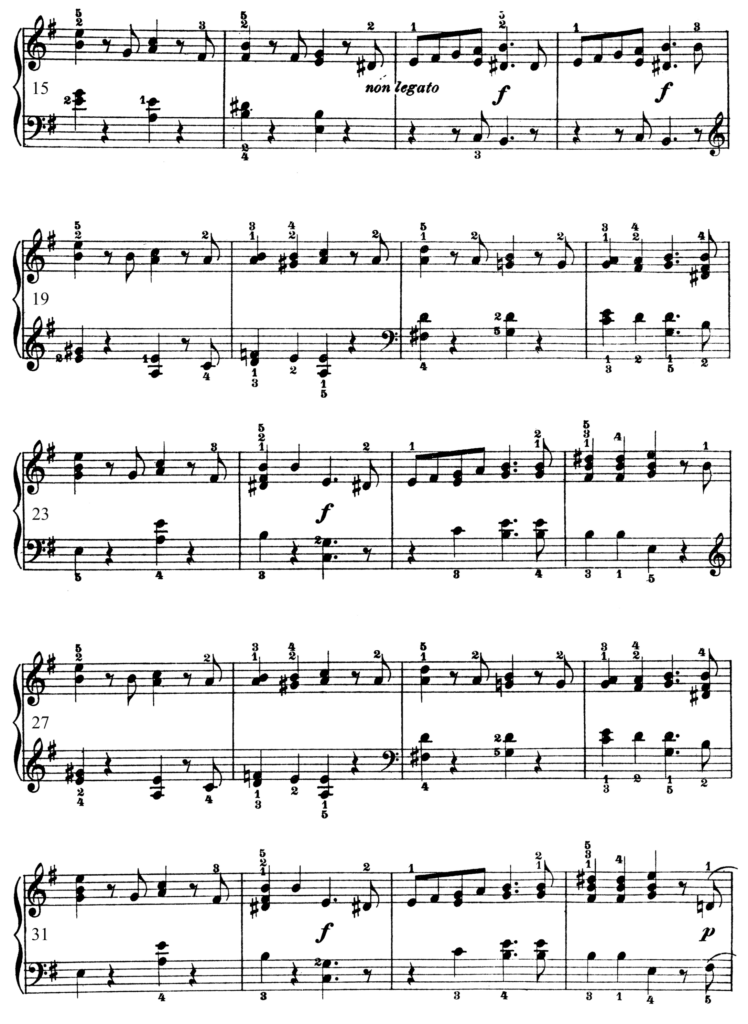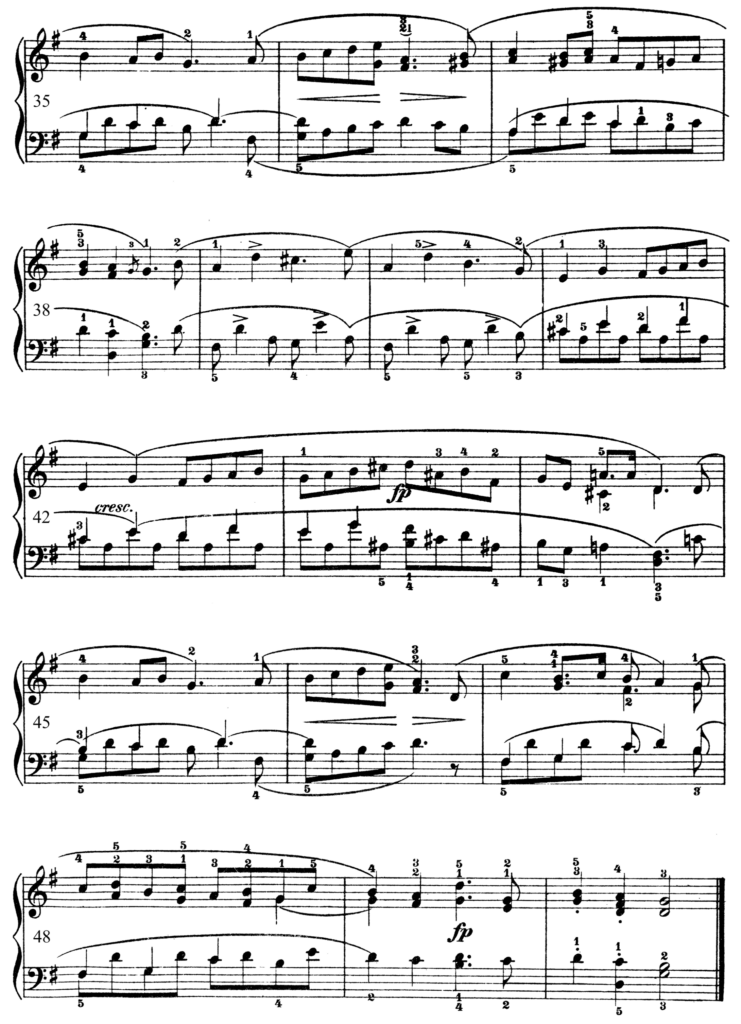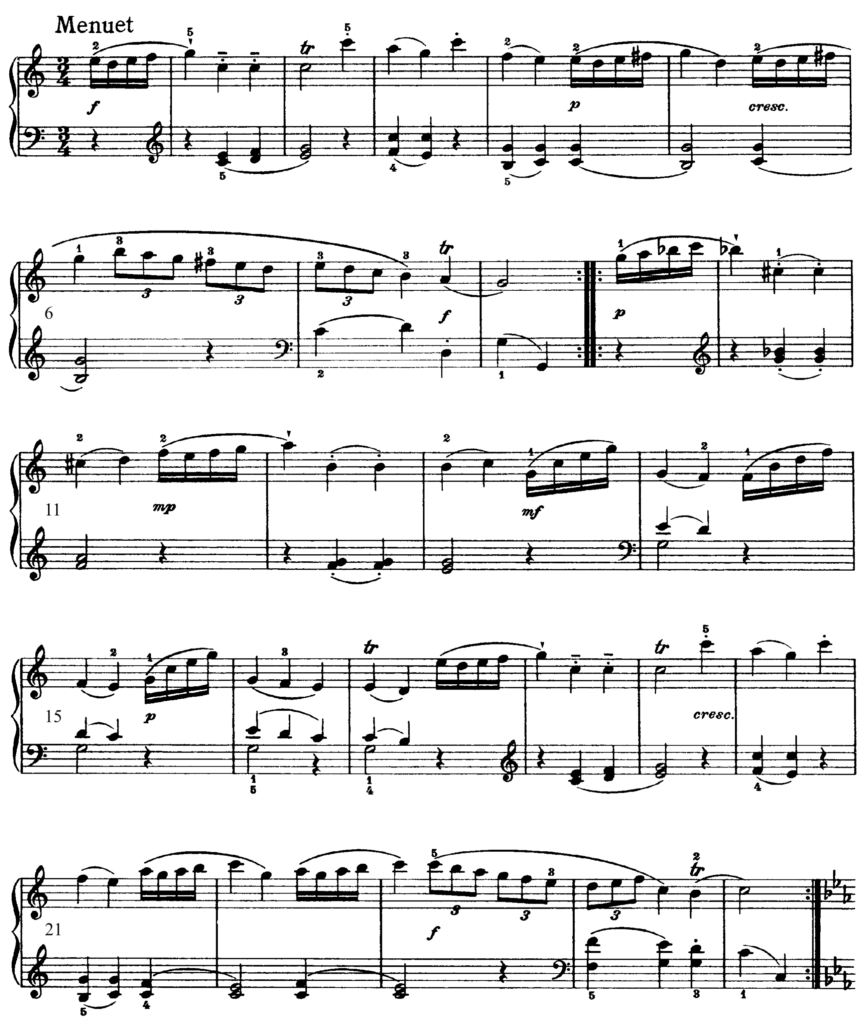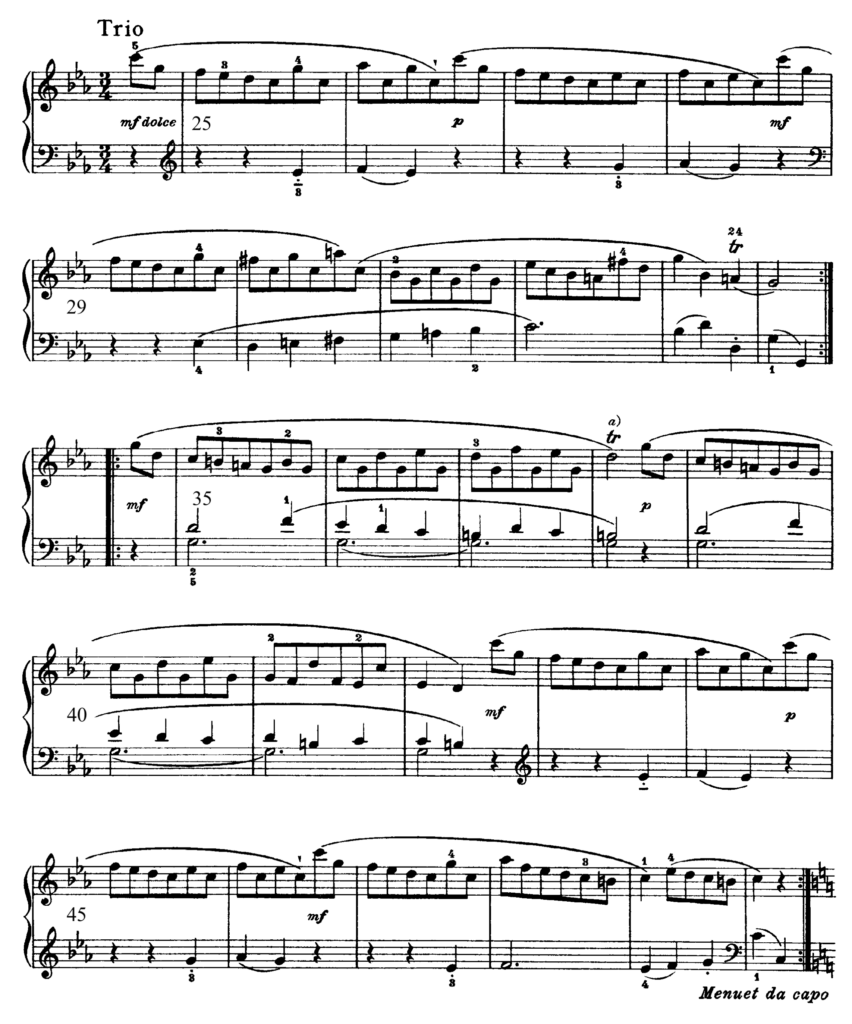Main Body
35 Ternary form
Learning goals for Chapter 35
In this chapter, we will learn:
- Terminology related to three-part forms
- How to approach analyzing pieces that are in three large contrasting sections
Simple ternary form
A piece is in if it is in three large sections, where the outer sections are roughly equivalent in proportion. The prototypical ternary design is A B A’. The primary difference between and ternary form is proportion. In rounded binary, we perceive two distinct sections, and the return of A is shorter than the initial statement, most often because of repetition of the first section. In ternary, we perceive three distinct sections, and the return of A is the same length as the initial statement of A. In this case, the restatement of A is subsumed as part of the larger B (second) section. Figure 35‑1 illustrates these differences.
There also tends to be more contrast in the B section of ternary forms than in binary forms. If there is insufficient contrast between sections or some other aspect of ternary form is not present, the piece is considered .
The piece appearing in Example 35‑1 is organized in three parts, exemplifying simple ternary form. Its form diagram, which appears in Figure 35‑2, shows the primary means of contrast in this piece—the B section is in the key of the dominant (G major), creating harmonic contrast with the outer A sections, which are in the tonic key of C major.
Example 35‑1. Robert Schumann, op. 68, no. 3, “Trällerliedchen” from Album for the Young
Listen to the piece, performed by Vladimir Feltsman, on Spotify.
Learn about German composer Robert Schumann (1810–1856) by reading this Oxford Music article, written by John Daverio and Eric Sams.
Figure 35‑2. Form diagram of Example 35‑1
Video: T65 Simple ternary form (7:50)
This video walks you through an analysis of simple ternary form in Robert Schumann’s op. 68, no. 3, “Trällerliedchen” from his Album for the Young (Example 35‑1). We identify the three large sections and their corresponding key areas, as well as phrase structure and cadences.
Compound ternary form
Ternary forms have the potential to be , which means that the internal sections also have their own formal designs (such as binary or ternary). Some texts refer to these as composite ternary forms. If such internal forms are not present, the form is considered , as demonstrated in Example 35‑1.
The most common example of a compound ternary form can be found in almost any Minuet and Trio movement. Typically, the structure involves statement of the minuet, followed by the trio, and restatement of the minuet—rendering an overarching A B A structure. The internal design of both the minuet and the trio is most often binary. The generic overall design of such a structure is given in Figure 35‑3. The term “da capo” signals the restatement of the minuet.
Figure 35‑3. Minuet and trio compound ternary form design
Example 35-2 shows another piece by Robert Schumann. This one is longer and has a more complex form, in that each of the three large sections has its own internal organization, making it an example of compound ternary form. For example, the A sections, which comprise mm. 1–14 and mm. 35–51, each have their own internal ternary structure, as shown in the form diagram for this piece in Figure 35‑4.
Example 35‑2. Robert Schumann, op. 118a, Kinder Sonate no. 1 from Three Piano Sonatas for the Young
Listen to this piece, performed by Peter Frankl, on Spotify.
Learn about German composer Robert Schumann (1810–1856) by reading this Oxford Music article, written by John Daverio and Eric Sams.
Figure 35‑4. Form diagram for Example 35‑2
Video: T66 Compound ternary form (11:16)
This video introduces the concept of compound ternary form through an analysis of Robert Schumann’s op. 118a, Kinder Sonate no. 1 from Three Piano Sonatas for the Young (Example 35-2).
Other variants
There are also variant types of ternary form that don’t use an A B A’ structure, such as (a common variant, which we will study in Chapter 36) and (which is rare). Form designs for each of these are shown in Figure 35‑5 and Figure 35‑6 respectively.
Figure 35‑5. Three-part strophic form

Cues for analysis
Whenever you encounter a new piece that appears to be in three large parts, consider the questions in Figure 35‑7, which can guide and inform your analysis.
Figure 35‑7. Cue sheet for ternary form
(1) Is this piece a true ternary or some type of variant (, , or )? If incipient, specify what conditions are lacking.
(2) What is the basic formal diagram for this piece? Include:
- measure numbers
- key areas (account for all modulations) shown as letters (e.g., CMA or Ami) as well as in Roman numerals (e.g., I or vi)
- uppercase letters to designate large sections
- slurs or bubbles labeled with lowercase letters to designate phrases
- cadence labels
- other sections, such as , transitions, or , when used
(3) Do any sections have an internal formal design, thus creating a form? If so, how are the internal sections organized?
(4) Examine how the primary musical elements (sound, melody, harmony, rhythm) are used for unity and contrast between the A and B sections.
(5) Compare the outer sections. How similar are they? What differences occur?
EXERCISE 35-1 Form analysis: Haydn Minuet and Trio
Listen to and study the following movement from an early piano sonata by Franz Joseph Haydn, Worksheet example 35‑1. This movement uses a compound ternary form, following the Minuet and Trio model, using a “da capo” indication at the end of the Trio, which means you go back to the beginning and play the Minuet again. Each of the individual big sections, i.e., the “Menuet” and the “Trio,” have their own internal form designs, and this makes the overall form compound.
With this in mind, answer the following questions:
- Consider just the “Menuet” (mm. 1–24). What term(s) best describe(s) the form of this section?
- Consider just the “Menuet” (mm. 1–24). What is the overall key of this section?
- The first cadence occurs in mm. 7–8. What type of cadence is this and in what key?
- The second cadence cadence in m. 16. What type of cadence is this and in what key?
- In m. 9, there is a chromatic chord. Thinking in the key of C major, what is the best label for this chord? Does it resolve in the way you might expect it to?
- The third cadence occurs in mm. 23–24. What type of cadence is this and in what key?
- Consider just the “Trio” (mm. 25–60). What term(s) best describe(s) the form of this section?
- Consider just the “Trio” (mm. 25–60). What is the overall key of this section? What is the relationship between the overall key of the trio and the overall key of the minuet?
- A cadence occurs at mm. 33–34. What type of cadence is this and in what key?
- Another cadence occurs at m. 38 and another at m. 42. What type of cadence are these and in what key?
- The final cadence occurs in mm. 59–60. What type of cadence is this and in what key?
Create a form diagram for this movement. Be sure to include:
- big sections labeled with capital letters
- repeat signs
- measure numbers where phrases and sections begin and end
- bubbles or slurs representing the phrases
- phrases labeled with lowercase letters
- key areas shown beneath the diagram, in both Roman numerals (showing the relationship of keys) and letter names
Worksheet example 35‑1. Franz Joseph Haydn, Keyboard Sonata in C major, Hob. XVI: 3, mvt. 3
Listen to this piece, performed by Rudolf Buchbinder, on Spotify.
Learn about Franz Joseph Haydn (1732–1809) by reading this Oxford Music Online article, written by Georg Feder and James Webster.
Listen to the audio examples featured in this chapter here: Spotify playlist for ternary form
Supplemental materials for Chapter 35
formal design in which the piece comprises three large sections, where the outer sections are roughly equivalent in proportion
term describing pieces in binary form in which a portion of the A section returns at the end of the B section
ternary form in which there is insufficient contrast between sections or some other aspect of ternary form is not present
form of pieces in three large sections, each of which has its own internal organization (usually a binary or ternary form)
designation for three-part (ABA) forms whose sections do not have internal forms
form consisting of repeating sections (called strophes, verses, or stanzas), each with different lyrics set to the same melody and harmonic content
ternary forms that have successive contrasting sections, A B C
beginning section of a piece or movement
ending section of a piece or movement
![left image reads "rounded binary," above capital letters A [space] B, which are above smaller capital letters A A B A'. Right image reads "ternary" above capital letters A [space] B [space] A-prime](https://pressbooks.macalester.digital/multimodalmusicianship/files/2023/05/image82-1.png)

